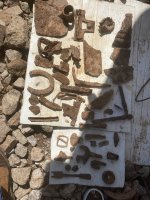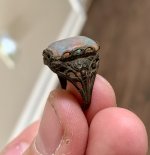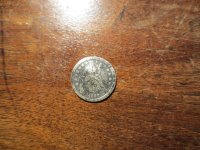Gypsy Heart
Gold Member
Continuing accounts relative to the Pottawattomie Indians, I will repeat the story told to me by the late Col. Kline G. Shryock, who was Provost Marshal here, during the Civil War. When I came to Rochester, in 1873, he was senior partner of the law firm of Shryock & Jemison, and their office was the front and second rooms, second floor of the Mammoth Building, a three-story wooden structure occupying the ground between Dawson & Coplen’s drug store and the alley south, where stands Levi’s dry goods store, that big building being destroyed by fire in the d summer of 1874. After the present brick buildings were erected on the same ground, Col. Shryock was Justice of the Peace for Rochester township, and had an office in the back room over the location of Carter’s bookstore, where I visited with him on may occasions to hear his experiences in pioneer times. In 1884 he was Postmaster for Rochester, and while thus engaged it was Col. Kline G. Shryock that signed my recommendation for the extension credit with printers’ supply firms n Chicago, for my first business venture, that kindness retaining my continued respect to this day, teaching a lesson of honor, honesty and integrity that has been a safe guide for the keeping of public confidence, a virtue no wealth of gold can purchase
“Col. Shryock recounted that in compliance with certain treaties entered into between the U.S. Government and Pottawattomie Chiefs Wau-Ke-was, and Pau-koo-shcuk, with Able C. Pepper as commissioner, a stipend of two thousand dollars per annum, in silver, was the annuity to pass to the Indians, payment to be effected on the south bank of Tippecanoe river, at a point about a quarter-mile up stream from the Michigan road bridge. The first few annual pay dates, which included a period of twenty years, constituted a sort of general Indian festivity, when the Pottawattomies would assemble from Marshall and Fulton counties, the Braves making their X mark to their names on the U.S. roster receipt. In preparation for this annual function, U.S. Government agents would apportion the silver money in pokes, load it into a wagon at Fort Wayne, and with provisions and necessary accouterment, would start on a two or three days’ journey through the woods to the counsel place we have long since known as Pottawattomie Paradise.
“Now to tell the shame of crime- the dishonor, dishonesty, perfidy, puerility, sneaking, stealthy, pusillanimous, wicked thievery of white mountebanks. Oh, can the bones of such men lie at rest in their graves?
“In the afternoon following the morning departure of the Government wagon from Fort Wayne, such characters would follow the trail of the Government vehicle, their wagon bearing blankets, beads, hunting knives, trinkets, rifles, ammunition, and many glittering generalities to attract Indian covetousness, and, lastly, a barrel of whisky. The arrival of this outfit was timed to occur immediately after the departure of the Government agents, and the first trick on the program was to “set-em-up” to all bucks having received money for their lands. When those unsophisticated, innocent men became hilariously intoxicated, the blankets, etc, would be sold to them, stolen back and the same blanket again sold to the same Indiana at a higher price, that stunt being repeated as often as four times for a certain victim. It is evident that when the crooks got most of the two thousand dollars, they would skedaddle with their swag, leaving Indians impoverished of both lands and their money. An yet, in face of these facts, the “wets” of this day have the unmitigated gall to have the “dry” imply that whiskey was innocent of crime in pioneer times, that intoxicants were pure and the use thereof a blessing to humanity: that the much-advertised crime wave of today is all due to the “joke” of the Volstead law and “weakness” of the Eighteenth amendment to our Federal Constitution. Shame on the intelligence of any young man who assumes that the Amendment is a failure, a fizzle and a fake. In this single instance is sufficient object lesson to convince any honest conscience that the “wet” rabble is more to encourage free booze than to hold a profound respect for the fundamental law of our country and a loyal defense of its flag.
I could not well avoid this divergence, as its truth is so patent to conditions of the past and present. Continuing with Col. Shryock’s story, he stated that these annual hospitable (?) holdups finally put their victims wise to their misfortunes, so old Chief Ben-nack, Chief Aub-bee-naub-bee, Chief Naswau-gee and Chief Pau-koo-shuck issued stringent orders to all younger bucks, that on coming of the pay-wagon thereafter, all their money should be hidden before the arrival of the whisky wagon, and that it would be a serious offense against the authority of their Chiefs not to obey the command.
“There were no First National Banks or safety deposit boxes at that time, so the Pottawattomies buried bushels of silver along Tippecanoe river and about the shore of Lake Manitou. When Gen. John Tipton and his soldiers were sent here on 1838, to remove the Pottawattomies to their new reservation in Kansas, those humble first Americans were so sorrowful, humiliated, disgraced and discouraged that they merely marched before the bayonet without thought of their buried treasure, for turning their backs to the graves of fathers, mothers and children was far greater stress to them than leaving silver coins, which meant no more intrinsic worth to them than as many pants-buttons are to us. It was Col. Shryock’s firm conviction that there are hundreds of dollars in silver still buried near the river and lake if only we knew where to look.
“ At least partly in the substantiation of buried treasure, is the fact that about 1884, an Indian came here from Michigan, He had a crude pencil map which he claimed was give to him by his grandfather, by which he could locate buried money. He and the late Andrew Edwards, a pioneer citizen, dug large holes at the river, but the passing of a half century had removed toe landmarks indicate, hence nothing was found. However, that failure can not deny the probability of the burial of the money the could not fine.
“Good citizens of Rochester, please pause and consider. Our homes, schools, churches, public buildings, business blocks, railroads, highways – all are built on lands veritably “snouged” from the untutored children of the forest, at bargains that would put men in the penitentiary today for similar advantage against innocence. We hold deeds in perpetuity for our homes and property, and those deeds were honestly obtained as truly liquidated, but can our conscious pride be charged as particeps criminis in this generation, when we realize that the Pottawattomie Indians were wickedly robbed by first crippling their minds with whiskey, a vile intent and a flagrant crime too repugnant for any legitimate excuse. Let “wets” answer that record of the early piety of booze and booze venders.”
http://freepages.genealogy.rootsweb.ancestry.com/~berta/bittersabf.html
“Col. Shryock recounted that in compliance with certain treaties entered into between the U.S. Government and Pottawattomie Chiefs Wau-Ke-was, and Pau-koo-shcuk, with Able C. Pepper as commissioner, a stipend of two thousand dollars per annum, in silver, was the annuity to pass to the Indians, payment to be effected on the south bank of Tippecanoe river, at a point about a quarter-mile up stream from the Michigan road bridge. The first few annual pay dates, which included a period of twenty years, constituted a sort of general Indian festivity, when the Pottawattomies would assemble from Marshall and Fulton counties, the Braves making their X mark to their names on the U.S. roster receipt. In preparation for this annual function, U.S. Government agents would apportion the silver money in pokes, load it into a wagon at Fort Wayne, and with provisions and necessary accouterment, would start on a two or three days’ journey through the woods to the counsel place we have long since known as Pottawattomie Paradise.
“Now to tell the shame of crime- the dishonor, dishonesty, perfidy, puerility, sneaking, stealthy, pusillanimous, wicked thievery of white mountebanks. Oh, can the bones of such men lie at rest in their graves?
“In the afternoon following the morning departure of the Government wagon from Fort Wayne, such characters would follow the trail of the Government vehicle, their wagon bearing blankets, beads, hunting knives, trinkets, rifles, ammunition, and many glittering generalities to attract Indian covetousness, and, lastly, a barrel of whisky. The arrival of this outfit was timed to occur immediately after the departure of the Government agents, and the first trick on the program was to “set-em-up” to all bucks having received money for their lands. When those unsophisticated, innocent men became hilariously intoxicated, the blankets, etc, would be sold to them, stolen back and the same blanket again sold to the same Indiana at a higher price, that stunt being repeated as often as four times for a certain victim. It is evident that when the crooks got most of the two thousand dollars, they would skedaddle with their swag, leaving Indians impoverished of both lands and their money. An yet, in face of these facts, the “wets” of this day have the unmitigated gall to have the “dry” imply that whiskey was innocent of crime in pioneer times, that intoxicants were pure and the use thereof a blessing to humanity: that the much-advertised crime wave of today is all due to the “joke” of the Volstead law and “weakness” of the Eighteenth amendment to our Federal Constitution. Shame on the intelligence of any young man who assumes that the Amendment is a failure, a fizzle and a fake. In this single instance is sufficient object lesson to convince any honest conscience that the “wet” rabble is more to encourage free booze than to hold a profound respect for the fundamental law of our country and a loyal defense of its flag.
I could not well avoid this divergence, as its truth is so patent to conditions of the past and present. Continuing with Col. Shryock’s story, he stated that these annual hospitable (?) holdups finally put their victims wise to their misfortunes, so old Chief Ben-nack, Chief Aub-bee-naub-bee, Chief Naswau-gee and Chief Pau-koo-shuck issued stringent orders to all younger bucks, that on coming of the pay-wagon thereafter, all their money should be hidden before the arrival of the whisky wagon, and that it would be a serious offense against the authority of their Chiefs not to obey the command.
“There were no First National Banks or safety deposit boxes at that time, so the Pottawattomies buried bushels of silver along Tippecanoe river and about the shore of Lake Manitou. When Gen. John Tipton and his soldiers were sent here on 1838, to remove the Pottawattomies to their new reservation in Kansas, those humble first Americans were so sorrowful, humiliated, disgraced and discouraged that they merely marched before the bayonet without thought of their buried treasure, for turning their backs to the graves of fathers, mothers and children was far greater stress to them than leaving silver coins, which meant no more intrinsic worth to them than as many pants-buttons are to us. It was Col. Shryock’s firm conviction that there are hundreds of dollars in silver still buried near the river and lake if only we knew where to look.
“ At least partly in the substantiation of buried treasure, is the fact that about 1884, an Indian came here from Michigan, He had a crude pencil map which he claimed was give to him by his grandfather, by which he could locate buried money. He and the late Andrew Edwards, a pioneer citizen, dug large holes at the river, but the passing of a half century had removed toe landmarks indicate, hence nothing was found. However, that failure can not deny the probability of the burial of the money the could not fine.
“Good citizens of Rochester, please pause and consider. Our homes, schools, churches, public buildings, business blocks, railroads, highways – all are built on lands veritably “snouged” from the untutored children of the forest, at bargains that would put men in the penitentiary today for similar advantage against innocence. We hold deeds in perpetuity for our homes and property, and those deeds were honestly obtained as truly liquidated, but can our conscious pride be charged as particeps criminis in this generation, when we realize that the Pottawattomie Indians were wickedly robbed by first crippling their minds with whiskey, a vile intent and a flagrant crime too repugnant for any legitimate excuse. Let “wets” answer that record of the early piety of booze and booze venders.”
http://freepages.genealogy.rootsweb.ancestry.com/~berta/bittersabf.html





